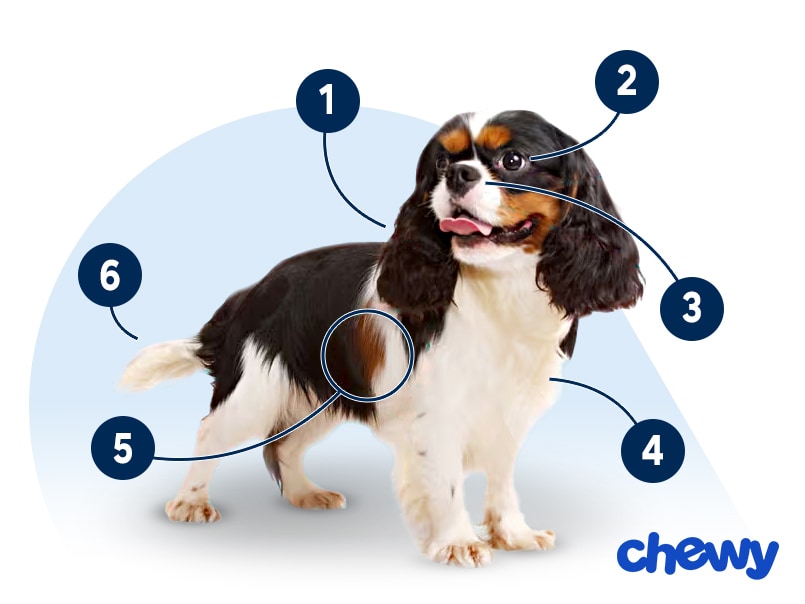Cavalier King Charles Spaniel
Updated June 4, 2025
Cavalier King Charles Spaniel
Updated June 4, 2025
Cavalier King Charles Spaniel dogs are best for people who want an "up-for-anything" companion. They thrive in both low- and high-activity households and live for playtime and impromptu cuddle sessions. These pups are excellent family dogs.
Gentle, Sweet, Jolly
Male: 13-18 pounds
Female: 13-18 pounds
Male: 12-13 inches
Female: 12-13 inches
12 to 15 years
Blenheim, Tricolor, Ruby, Black and Tan
The Cavalier King Charles Spaniel has never met a stranger. Expect to make a new friend everywhere you go with this bubbly, happy-go-lucky pup by your side. Gentle and patient, Cavaliers don’t really have an agenda for the day. The only thing on their to-do list is “hang out with you.” Their adaptability to new situations makes them great company for whatever you have planned. So, whether you’re running errands, lounging on the couch or having friends over for game night, your Cavalier will be happy to tag along.
Cavalier King Charles Spaniel Characteristics
Cavalier King Charles Spaniel Appearance
Cavalier King Charles Spaniels’ big, brown eyes are the window into their sweet souls. They prance around gleefully with their signature floppy ears hanging playfully, and their tails wagging merrily, always ready to tag along wherever you may go. Their beautiful, medium-length coats come in four color patterns: black and tan, tricolor (black, tan and white), Blenheim (chestnut and white) and ruby.

- Ears
Cavalier King Charles Spaniels' ears are long and flowing, resting high—but not close—on top of their head. They feature loads of feathering, and when Cavaliers are alert, their ears shift a bit forward to frame the face.
- Eyes
Their warm, dark brown eyes give off a subtle sheen and are large, round and set wide apart.
- Nose
Cavalier noses are slightly tapered and uniformly black.
- Coat Length
Their coats are medium length, super silky and don't have any curl, though sometimes a little waviness is possible.
- Coat Color
Their coat colors come in four options: tricolor (black, white and tan), black and tan, Blenheim (chestnut and white) or ruby.
- Tail
Their tails are always cheerily moving when the dog is active. Cavalier tails are rarely carried higher than their back. The AKC breed standard allows for docking the tail. Docking involves cutting a portion of the dog’s tail off when they are puppies. Veterinary groups along with many US states and countries have banned this procedure due to medical and behavioral reasons. If you are interested in this procedure, schedule a consultation with your veterinarian.
Cavalier King Charles Spaniel Temperament
The Cavalier King Charles Spaniel is a sweet and gentle toy dog breed with no shortage of playfulness to share with the whole family. They’re adaptable and easy-going, ready for everyday adventures or spending quality time relaxing at home. Cavaliers are known to mirror their pet parents; they easily adapt to fit your lifestyle, whether you’re super active or more low-key.
Their love language is giving and receiving affection; these little dogs will boost your mood and shower you with love. True social butterflies, Cavaliers enjoy most social settings, and take pride in getting to know every human they may encounter. And because of their big hearts and good nature, they can also be effective therapy dogs.
With their cheerful demeanor, it’s no surprise that Cavaliers get along well with people and other animals—including cats. Because they’re a small breed, they may be a little timid around larger dogs at first. So, don’t put too much pressure on them to play with the “big boys” until your Cavalier feels comfortable doing so.
If you’re not up for making new friends, a Cavalier King Charles Spaniel puppy may not be the dog for you. Their over-the-top friendliness is best for folks looking for a way to meet new people. After all, with their fun-loving attitude and zest for life, they’re likely to get you striking up conversations with new friends everywhere you go.
How to Care for a Cavalier King Charles Spaniel
Much like their relaxed, go-with-the-flow personality, Cavaliers are pretty low maintenance when it comes to grooming, even though their coat isn’t short. With occasional brushing and bathing, their signature coat can stay shiny and healthy year-round. Because they enjoy cuddles and being lap dogs so much, you can easily make groom-time an experience that strengthens the bond you have with your Cavalier.
Grooming
Training
Diet
Exercise
Environment
Cavalier King Charles Spaniel Health
Even though they have a lifespan of 12-15 years, Cavalier King Charles Spaniels are prone to a number of health issues, especially as they age. But that shouldn’t stop you from bringing one of these lovable pups into your life. It’s important to be aware of these issues up front so you can help your pup live a long, happy life.
- Mitral Valve Disease: This is a condition that occurs when the mitral valve of the heart deteriorates, causing the heart to work less efficiently when it pumps blood. In Cavalier King Charles Spaniels, this disease often leads to congestive heart failure. Vets perform several tests that examine different aspects of the heart to catch any issues early on. Surgery is not usually an option, but drugs and treatments help improve heart function. Mitral valve disease may be inherited, so affected dogs should not be used for breeding purposes.
- Hip Dysplasia: Hip dysplasia is a condition where the femur doesn’t fit correctly in the hip socket. It can lead to early signs of arthritis, including limping or general pain when walking. Because they are a smaller breed, Cavaliers may not show symptoms until they’re older. Depending on the severity, treatments can include changes in diet and exercise, weight management, medications, physical therapy or even surgery.
- Syringomyelia: This is a term used to describe fluid-filled cavities (called syrinx) that develop in the spinal cord. This is caused by an underlying Chiari-like malformation, when a dog’s brain is too big for the space inside their skull. Withdrawn behavior, vocalizing when running or jumping, discomfort when being picked up and scratching of the shoulder, neck and ear area are common symptoms—due to altered sensation and eventual pain. Treatment focuses mainly on pain management, as surgery is often not a viable option.
- Ear Infections: Inflammation of the ear canal (Otitis externa) can be common in Cavaliers. Their long, drooping ears are likely a contributing factor to this problem, but the exact cause is unknown. Often, dogs with otitis issues are found to have underlying allergy problems. Anti-inflammatory medications, frequently combined with topical antibiotics or antifungal compounds may help provide relief and reduce the inflammatory effects. In more severe cases, surgery may be needed.
- Eye Problems: Cavaliers are prone to a few eye diseases. Cataracts can cause blindness and may be corrected through surgery, depending on the dog’s age and health. Progressive retinal atrophy (PRA) also leads to blindness, but there is currently no treatment available. Dogs with cataracts or PRA often adjust well to the loss of eyesight. Cavaliers may also suffer from an inherited condition called dry eye. Here, the dog cannot produce tears to keep the eye moist, which can lead to corneal inflammation, ulceration or pigmentation. Early diagnosis is important to protect the eye. Treatments may include antibiotics or anti-inflammatories, and daily ointments to help produce and replace tears are often prescribed.
- Luxating patella: Luxating patella (kneecap) is a condition that occurs when the groove that holds the patella in position is too shallow, allowing the patella to escape its normal position when the knee joint bends and straightens. This condition is seen more commonly in smaller breeds and does not always cause discomfort, but it can lead to other painful problems, like torn cruciate ligaments, arthritis and more.
Cavalier King Charles Spaniel History
With a name as regal as the Cavalier King Charles Spaniel’s, it’s not the least bit surprising the breed has a royal history. They’re named after King Charles I, a 17th-century British monarch who evidently had several toy spaniels who accompanied him almost everywhere. He and his son, Charles II, had black and tan varieties, which have been around since at least the Renaissance times in Europe. Originally bred to be a bird hunter, their small, short stature and demeanor made them better suited to be companions and affectionate lap dogs.
Cavaliers were extremely popular among the noble classes and remained a go-to breed for aristocrats in the United Kingdom until the early 19th century. The Marlborough family was very involved with breeding Cavalier King Charles Spaniels at Blenheim Palace, turning their focus on the chestnut and white variety. During Queen Victoria’s reign, the breed was mixed with Asian toy breeds, such as Pugs and Japanese Chins. This cross-breeding changed the breed’s look and structure, evolving into a shape with a domed skull and flatter face than the dogs Charles I had. In fact, Charles’ dogs came close to extinction as this new variety dominated.
In the 1920s, people wanted the dogs portrayed in the old portraits of their ancestors. Roswell Eldridge, a wealthy American, challenged British breeders to breed Blenheim Spaniels “of the Old World type.” To win a cash prize, the breeders worked to bring back the old look—and they did. That’s when the Cavalier King Charles Spaniel was born. Where did the “cavalier” come from? The army that supported Charles I in the English Civil War was called Cavaliers, and thus we get “Cavalier” in Cavalier King Charles Spaniel.
The Cavalier became an American Kennel Club-recognized breed in 1995 and is the 14th most popular breed in America. It’s no wonder why—Cavaliers are highly prized for their affectionate and adaptable temperament. (And they’re so darn cute!) If you’re looking to add a Cavalier as a pet, you can find reputable breeders on the American Kennel Club’s website. A Cavalier puppy can cost between $1,800-$3,500. But for that price, you usually get a pup who’s been screened for health issues and may include pedigree papers. Or, you can check with local Cavalier King Charles Spaniel rescue organizations, keep an eye out for the breed at your local animal shelter, or search Chewy’s database of adoptable dogs in your area.
FAQs
Are Cavalier King Charles Spaniels hypoallergenic?
How long do Cavalier King Charles Spaniels live?
Are Cavalier King Charles Spaniels smart?
Do Cavalier King Charles Spaniels bark a lot?
What are the most common Cavalier King Charles Spaniel mixes?
Expert input provided by veterinarian Dr. Katie Billmaier, at Furry Friends Adoption, Clinic & Ranch; and Sparky Serka, head trainer at The Puppy Academy.
Breed characteristic ratings provided by veterinarian Dr. Sarah J. Wooten, DVM, CVJ, a veterinarian at Sheep Draw Veterinary Hospital in Greeley, Colorado; dog trainer and behavior consultant Irith Bloom, CPDT-KSA, CBCC-KA, CDBC, owner of The Sophisticated Dog, LLC, in Los Angeles; and certified animal behavior consultant Amy Shojai, CABC, in Sherman, Texas.
The health content was medically reviewed by Chewy vets.

































